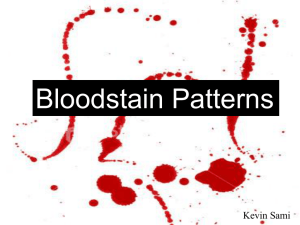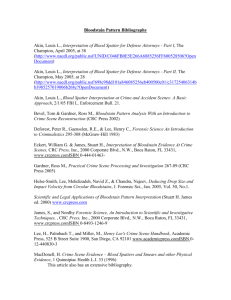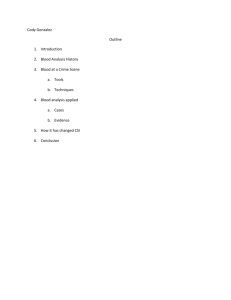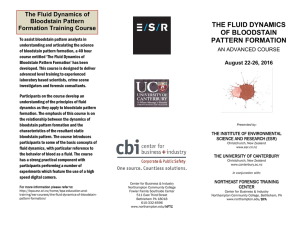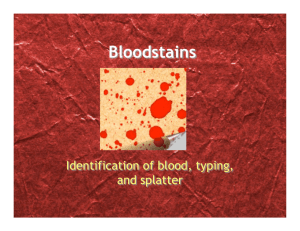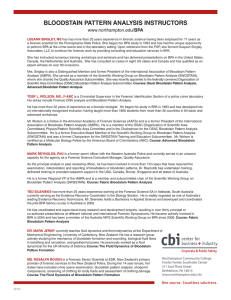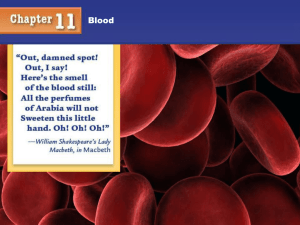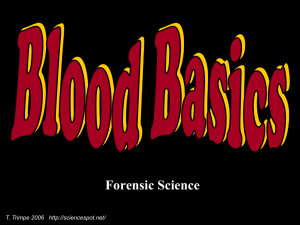Course outline
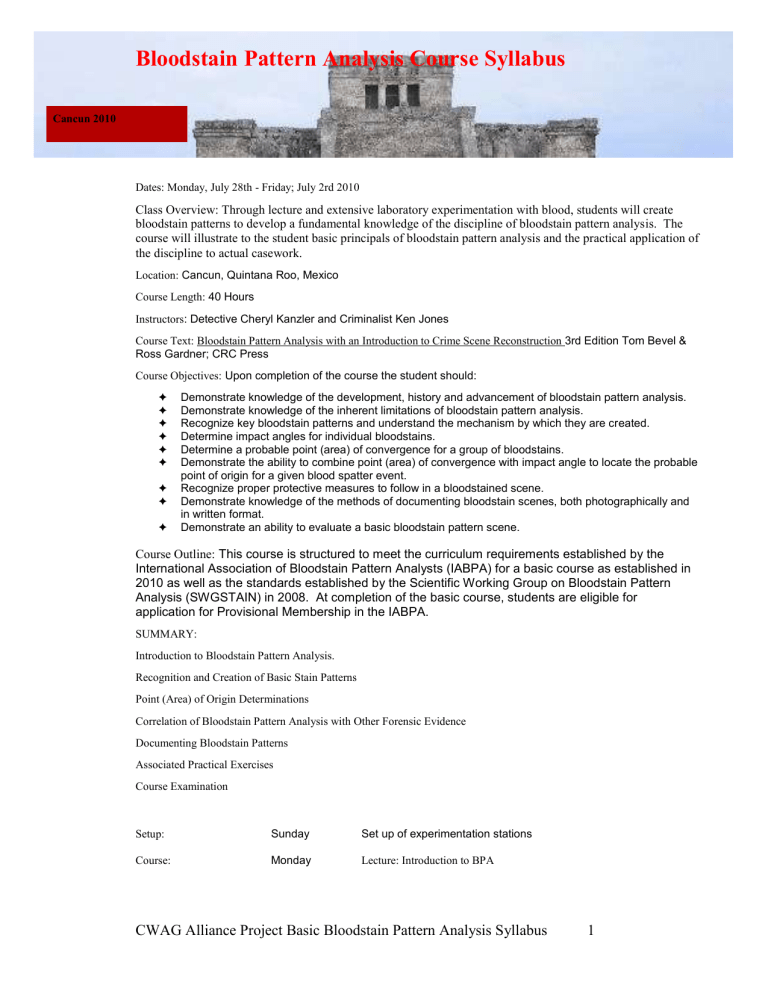
Cancun 2010
Bloodstain Pattern Analysis Course Syllabus
Dates: Monday, July 28th - Friday; July 2rd 2010
Class Overview: Through lecture and extensive laboratory experimentation with blood, students will create bloodstain patterns to develop a fundamental knowledge of the discipline of bloodstain pattern analysis. The course will illustrate to the student basic principals of bloodstain pattern analysis and the practical application of the discipline to actual casework.
Location: Cancun, Quintana Roo, Mexico
Course Length: 40 Hours
Instructors : Detective Cheryl Kanzler and Criminalist Ken Jones
Course Text: Bloodstain Pattern Analysis with an Introduction to Crime Scene Reconstruction 3rd Edition Tom Bevel &
Ross Gardner; CRC Press
Course Objectives: Upon completion of the course the student should:
✦
Demonstrate knowledge of the development, history and advancement of bloodstain pattern analysis.
✦
Demonstrate knowledge of the inherent limitations of bloodstain pattern analysis.
✦
Recognize key bloodstain patterns and understand the mechanism by which they are created.
✦
Determine impact angles for individual bloodstains.
✦
Determine a probable point (area) of convergence for a group of bloodstains.
✦
Demonstrate the ability to combine point (area) of convergence with impact angle to locate the probable point of origin for a given blood spatter event.
✦
Recognize proper protective measures to follow in a bloodstained scene.
✦
Demonstrate knowledge of the methods of documenting bloodstain scenes, both photographically and in written format.
✦
Demonstrate an ability to evaluate a basic bloodstain pattern scene.
Course Outline: This course is structured to meet the curriculum requirements established by the
International Association of Bloodstain Pattern Analysts (IABPA) for a basic course as established in
2010 as well as the standards established by the Scientific Working Group on Bloodstain Pattern
Analysis (SWGSTAIN) in 2008. At completion of the basic course, students are eligible for application for Provisional Membership in the IABPA.
SUMMARY:
Introduction to Bloodstain Pattern Analysis.
Recognition and Creation of Basic Stain Patterns
Point (Area) of Origin Determinations
Correlation of Bloodstain Pattern Analysis with Other Forensic Evidence
Documenting Bloodstain Patterns
Associated Practical Exercises
Course Examination
Setup:
Course:
Sunday
Monday
Set up of experimentation stations
Lecture: Introduction to BPA
CWAG Alliance Project Basic Bloodstain Pattern Analysis Syllabus 1
Cancun 2010
Basic Bloodstain Pattern Analysis
Tuesday
(Pre-Test) Purpose, History, Application of Scientific Method,
BioHazard, Liquid Blood Characteristics - (Force ,Flight, Impact),
Limitations in BPA conclusions.
Experimentation: Stain Shape, Impact Angle, Surface Effects,
Distance / Volume
Spatter Stains
Lecture: Linear: Arterial Spurt, Cast off, Drip Trail
Experimentation: (Respective Patterns)
Lecture: Non-linear ; Impact Spatter, Drip, Expectorate
Experimentation: (Respective Patterns & Voids)
Wednesday Non-Spatter Stains
Lecture: Irregular Margin; Blood into Blood, Gush, Smears (SW)
Experimentation: (Respective Patterns & Drying Times)
Lecture: Regular Margin; Pattern Transfer, Flow, Pool, Saturation
Experimentation: (Respective Patterns & Fly Spots)
Thursday Point (Area) of Origin Determination / Documentation
Lecture:
Lecture
Lecture:
Math and Physics, Stain Measurement, Impact Angle
: Methods for Point of Origin Determination
Documentation; Photography, Enhancement, Reports
Experimentation: Crime Scene Processing: (Photograph and measure; determine the approximate point of origin for an impact pattern, document bloodstain patterns present in the scene and create an analysis report of your findings.)
Friday Correlation of BPA with Forensic Sciences / Summary
Lecture: Presumptive tests, DNA, Wound Pathology, Sequencing
Experimentation: Presumptive test, Enhancement Chemicals
Lecture: Presentation of Findings at Trial
Examination: Written exam of course material.
Closing
CWAG Alliance Project Basic Bloodstain Pattern Analysis Syllabus 2
